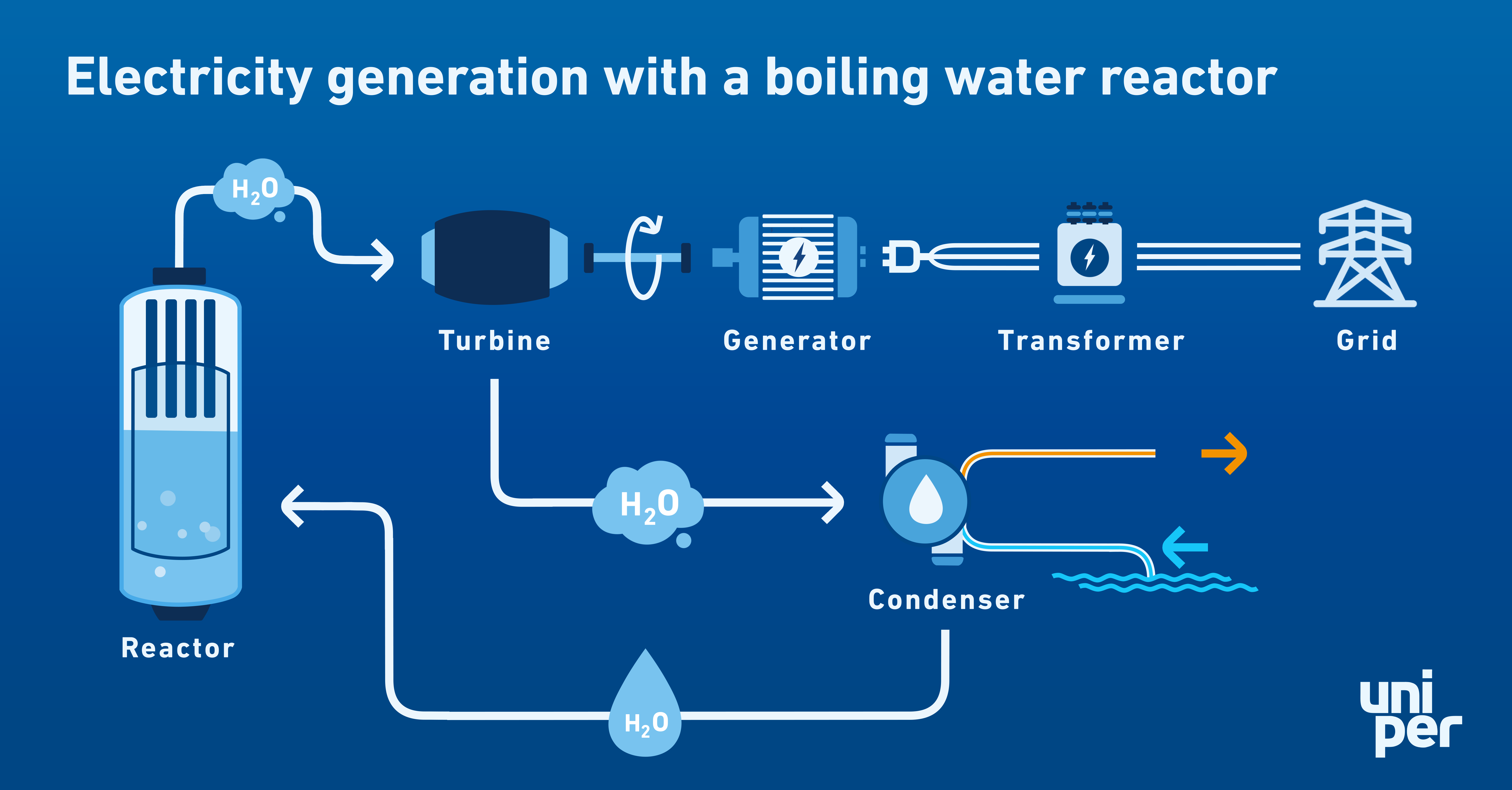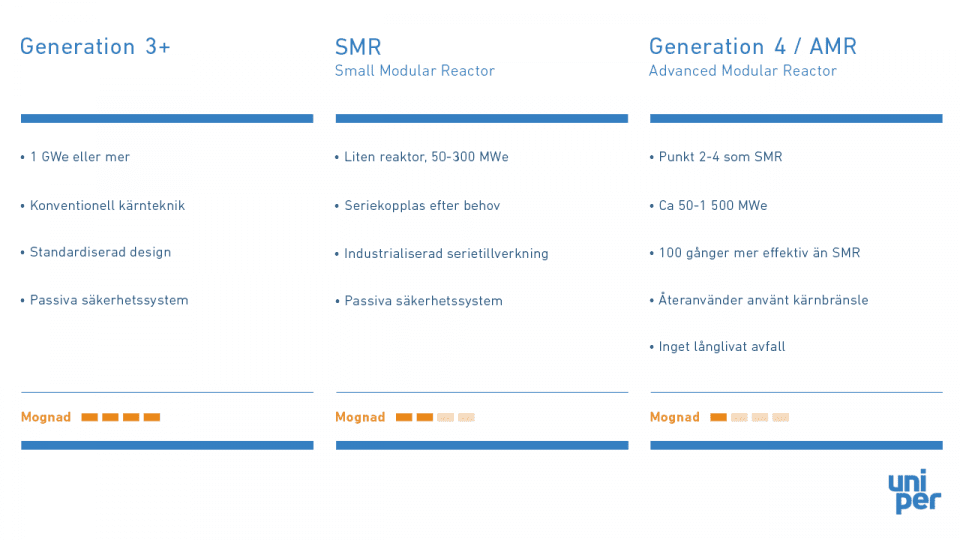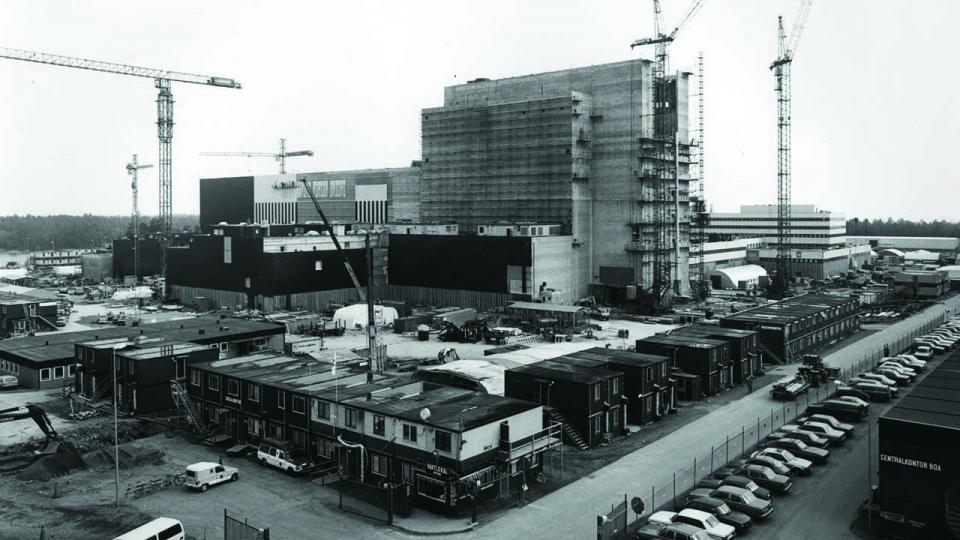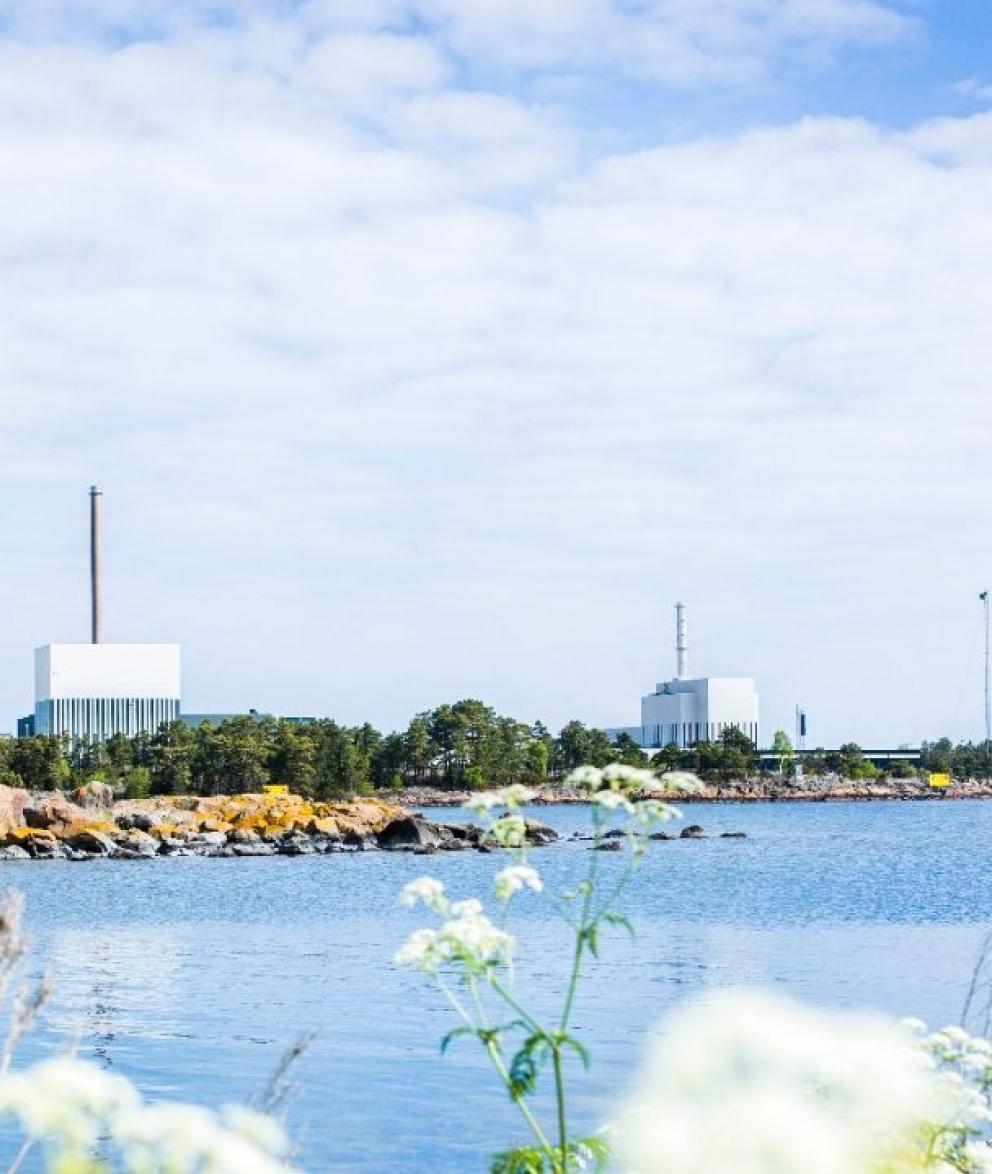What nuclear power means for Sweden
Electricity is more complicated than you might think. Since it is not possible to store large amounts of electricity, it must be produced at the moment we use it. In addition, the electricity must have exactly the right voltage frequency so that there are no disturbances in the electrical system.
We currently have six reactors in operation, which in 2024 accounted for approximately 30% of all the electricity produced in Sweden. Uniper takes overall responsibility for our part of Swedish nuclear power.
How a nuclear power plant works
Nuclear power is a way of harnessing the energy available everywhere – in atoms, or rather, in their nuclei. Hence the name “nuclear power.

It was Albert Einstein who first theorized it would be possible to use this power. He realized this thanks to his theory of relativity, E = mc2. This possibility then became a reality with the splitting of uranium-235. The energy released by splitting uranium-235 is used to boil water. This generates steam, which drives a turbine. The turbine in turn drives a generator, which generates a large part of the electricity used in Swedish households.
The future of nuclear power
Although it is easy to believe that all nuclear power is one and the same thing, the fact is that it consists of a range of different technologies that all have one thing in common – the are based on the splitting of atomic nuclei (fission) to release large amounts of energy. Since the commissioning of the first commercial reactor in the 1950s, technology has made some rapid leaps forward. Present-day reactors, which belong to the second or third generation, are considerably more technologically advanced than first-generation reactors.
At the same time, nuclear power reactors of today are subject to certain limitations. For example, the reactors utilize only between half and one percent of the energy content of uranium. Uranium is a finite resource and the radioactive waste from reactors must be stored safely for 100,000 years before its radiation decays completely. Furthermore, it is costly to build new nuclear power plants. However, researchers are now developing the next generation’s nuclear power plants, which will be more efficient and safer, and available at a lower cost than those of today.

Fourth-generation nuclear power will be able to utilize nuclear fuel with 100 times the efficiency of today. The waste that ultimately remains will need final repository storage for a few hundred years, instead of 100,000 years, as with plants today. Available stocks of nuclear fuel that we know of today would be sufficient to supply the entire world with electricity for a thousand years.
For now, Gen IV reactors are only at the design stage. At the same time, numerous players are now using the landmark achievements of Gen IV research in smaller-scale reactors, known as a small modular reactor (SMR). However, SMRs do not need to be built based on fourth-generation technology. On the contrary, it is more commonplace to further develop a third-generation reactor, but on a smaller and more flexible scale.
Our nuclear power operations
In a nuclear power plant, operations are characterized by a very high level of safety awareness. Both in daily operation and in the handling of reactors that are not in operation. Even when dismantling and demolishing nuclear power plants, we do so responsibly and safely.
Sweden has three active nuclear power plants: OKG, Ringhals and Forsmark. Uniper has a unique position, since we are joint owners in all of them. We are the majority owner of OKG in Oskarshamn and a minority owner of Ringhals and Forsmark. We also own Barsebäcksverket, the first commercial nuclear power plant in Sweden, which is now decomissioned and is being dismantled in line with the Swedish system, which means that the owners of the nuclear power plants take full responsibility troughout their life cycle.
Reactor unit |
Commercial date |
Status |
Net capacity (MW) |
Delivery 2024 (TWh) |
Reactor type |
|---|---|---|---|---|---|
01 |
1972 |
Closed 2017 |
492 |
0 |
Boiling water |
02 |
1975 |
Closed 2015 |
661 |
0 |
Boiling water |
03 |
1985 |
Active |
1,450 |
10,8 |
Boiling water |
B1 |
1975 |
Closed 1999 |
630 |
0 |
Boiling water |
B2 |
1977 |
Closed 2005 |
630 |
0 |
Boiling water |
R1 |
1976 |
Closed 2020 |
865 |
0 |
Boiling water |
R2 |
1975 |
Closed 2019 |
865 |
0 |
Pressurized water |
R3 |
1981 |
Active |
1,064 |
7.6 |
Pressurized water |
R4 |
1983 |
Active |
1,130 |
8,6 |
Pressurized water |
F1 |
1980 |
Active |
1,018 |
8,3 |
Boiling water |
F2 |
1981 |
Active |
1,028 |
7.4 |
Boiling water |
F3 |
1985 |
Active |
1,230 |
6,1 |
Boiling water |
The OKG reactors
OKG has an operating license to operate three nuclear power reactors on the Simpevarps peninsula north of Oskarshamn. The company is owned by Sydkraft/Uniper with 54.5% and Fortum with 45.5%. One of the reactors is in operational operation, the two oldest reactors are about to be dismantled and decommissioned.
The boiling water reactor Oskarshamn 3 (O3) was connected to the electricity grid on March 3, 1985, with an installed capacity of 1,050 megawatts (MW).
In 2009, an extensive modernization project was carried out. During the project, a safety upgrade and a power increase to 1,450 MW were carried out. This makes O3 one of the world's largest boiling water reactors.
In 2020, an independent core cooling was installed. This means that the reactor now has the conditions for long-term operation until at least 2045, with the conditions to further extend the reactor's life into the 2060s.
During an extraordinary general meeting in October 2015, the decision was made to take reactors Oskarshamn 1 (O1) and 2 (O2) out of operation. This was a direct consequence of low electricity market prices and high taxation.
O1 was commissioned in 1971 as Sweden's first commercial nuclear power plant of the light water reactor type. When the reactor was decommissioned on June 17, 2017, it had delivered approximately 110,000,000 MWh of climate-efficient electricity.
O2 was decommissioned in 2013 for an extensive modernization project, with the final stage to have been completed in 2015. However, the reactor was never restarted.
Now both O1 and O2 are being dismantled and demolished along with the reactors at Barsebäck. Demolishing the four reactors in a joint portfolio and according to a joint strategy helps coordinate specialist expertise, safety, logistics and finances to our advantage.
Barsebäck
Barsebäck's nuclear power plant is located in Kävlinge municipality. Following a decision by the then government, the nuclear power plant's two reactors were closed in 1999 and 2005 respectively. Both reactors are covered by an ongoing decommissioning project, where the ambition is that conventional dismantling can begin in the 2030s.
Ringhals
The Ringhals nuclear power plant is located on the Värö peninsula in Varberg municipality, in Halland. The powerplant is 70.4% owned by Vattenfall and 29.6% by Sydkraft/Uniper. The facility has four reactors, the two oldest of which were shut down in 2019 and 2020. The two newest reactors will remain operational for long-term use until the 2040s.
Forsmark
Forsmark’s nuclear power plant is in Östhammar municipality in Uppland. The power plant is 66% owned by Vattenfall, 24.1% by Mellansvenska Kraftgruppen and 9.9% by Sydkraft/Uniper. The power plant has three reactors, all of which will remain operational for long-term use until the 2040s.
Maintenance outages at a nuclear power plant
A nuclear power plant closes for maintenance every year. During this time, the reactors are refueled and maintenance is conducted at the facility. After a maintenance outage, which takes one or two months, the reactor is ready for its next operating period.
Between 100 and 600 people are usually involved in a maintenance outage. Larger maintenance outages can require as many as 3,000 people for the task.
As a rule, maintenance outages are carried out during the summer, when the need for electricity is at a minimum. However, since Sweden has gone from twelve nuclear reactors to six, the capacity in southern Sweden has become more strained. The lack of dispatchable electricity generation and subsequent lack in capacity and support services make themselves known, even during the summer. There is no longer an ideal time of the year to carry out annual maintenance outages without affecting availability in the electricity system.
The history of nuclear power
Research into splitting the atom made huge gains in the 1930s. Due to World War II, initial research and development was directed primarily towards military uses. It wasn’t until after the war that research into civilian applications started in earnest. The world’s first commercial nuclear power plant was built in England in 1954, and the first in Sweden in 1972.

But research started in Sweden as early as the 1950s. Sweden’s first nuclear power plant was Ågestaverket, a pressurized heavy water reactor that also functioned as a combined heat and power (CHP) plant. The plant went into operation in 1963 and had a capacity of 80 MW when it was closed in 1974. By that point it had delivered a total of 800,000 MWh of heating to Farsta and 415,000 MWh of electricity. The reactor was demolished in the early 1980s. The previous reactor hall still remains, but after losing its nuclear facility categorization the space has been used as premises for events, exhibitions and so on.
Sweden’s second nuclear power plant was Marvikenverket, built at Marviken near Norrköping. Large portions were completed by 1968, with an intended capacity of 200 MW. The goal was for the plant to produce both electricity and plutonium for Sweden’s atomic bomb program. But when Sweden signed the Non-Proliferation Treaty in 1968, Marviken was closed in 1970. It had never received any fuel or provided any electricity.
Sweden’s first commercial reactor, Oskarshamn 1, went into commercial operation in 1972 at Oskarshamn nuclear power plant (OKG). The equipment was supplied by Allmänna Svenska Elektriska AB (ASEA) and was a boiling water reactor developed in Sweden, with a capacity of 440 MW.
Nuclear power in the electricity system
Electricity is consumed the moment it is generated, which places high demands on the synchronization between electricity generation and distribution. The electricity system must be able to handle changes in the electricity supply and demand in real time. To ensure a balance between generation and consumption, the voltage frequency in the electricity grid should be 50 Hz – not less than 49.9 Hz, and not more than 50.1 Hz.
The ability of the system to also maintain the voltage frequency during rapid deviations is dependent on the rotational energy being offered by the various power sources. If there is a lot of rotational energy, the system will have the time it needs to adjust the voltage frequency and thus be more stable, and the power quality will be higher. If there is low rotational energy, the voltage frequency will be difficult to maintain, the system will become less stable, and the power quality will deteriorate.
Nuclear power and hydropower are driven by large generators, which provide most of the rotational energy in the system. Solar and wind energy do not currently contribute to rotational energy, and the higher the proportion of weather-dependent electricity generation the more unstable the system becomes.
A voltage frequency of less than 49.0 Hz causes disruptions in supply. The problems can start with a small local disruption, whereby the frequency drop can rapidly escalate and spread to other areas, followed by a total system collapse with power outages of several hours.
Nuclear power and safety
Each nuclear power plant has a comprehensive safety system that prevents errors, prevents errors from leading to breakdowns and mitigates the consequences of a breakdown. Safety is always first in operations at our nuclear power plants. At the least sign of danger, the reactor is taken offline. Each reactor also has a built-in system that allows it to quickly shut itself down in case of a technical error.
In Sweden, the Swedish Radiation Safety Authority (SSM) exercises control over operations at nuclear power plants. SSM has full insight into operations and can conduct controls and inspections at any time. This includes a mandate to shut down a reactor.
There is also an international network in the nuclear power industry that puts safety at the top of the agenda and where operators can share their new experiences, methods and procedures. Through this exchange of knowledge, all facilities around the world have the necessary conditions to improve their safety work and maintain the highest level of safety.
Nuclear power and the climate
Since nuclear power is fossil-free, it does not give rise to any carbon dioxide emissions during operation. In addition, it has a very low climate impact over its entire life cycle, including construction, demolition and mining. The diagram shows how much greenhouse gas emissions each production type gives rise to during its life cycle, expressed per gigawatt-hour of electricity produced. Nuclear power's climate impact is on a par with hydropower and wind power, and lower than the life cycle emissions from both solar cells and biomass.
Nuclear power is a sustainable investment
The EU's decision to include nuclear power in the taxonomy of sustainable investments marks a milestone in the energy sector's transition towards a more sustainable future. This development means that nuclear power is officially recognized for its contribution to limiting climate change, while it is not considered to have any negative impact on other environmental goals.
For investors, this decision means a clear signal that investing in nuclear power projects is sustainable. It opens up a broader discussion about how investments in the energy sector can be designed to balance both short-term economic interests and long-term sustainability goals. By including nuclear power in the sustainable investment taxonomy, companies and financial institutions are given clear guidance to direct their resources to projects that promote both economic growth and climate change.
Find out more
How can we complement and eventually replace current nuclear power with new nuclear power systems.
One of the many innovations within nuclear for the last decades is the Small Modular Reactor, or “SMR.”
The nuclear power plants in Sweden today were built to last for a long time.






